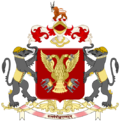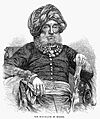Maharaja of Mysore facts for kids
Quick facts for kids Maharaja of the Kingdom of Mysore |
|
|---|---|

Royal coat of arms (1893)
|
|
| Details | |
| Style | His Highness |
| First monarch | Yaduraya Wodeyar |
| Last monarch | Jayachamaraja Wodeyar |
| Formation | 1399 |
| Abolition | 26 January 1950 |
| Residence | Mysore Palace |
The Maharaja of Mysore was the main ruler or king of the Kingdom of Mysore. This kingdom existed in what is now India, roughly from the late 1300s until 1950. The Maharaja's wife was known as the Maharani of Mysore.
Over time, the ruler's title changed. In the beginning, they were called poleygar, which means 'chieftain' in Kannada language. Later, they became raja, meaning 'king' (usually of a smaller area). Finally, they were known as maharaja, meaning 'great king' in Sanskrit and Kannada. This title was used for the rest of the kingdom's history.
The next ruler was usually a son or a close family member. If there was no direct heir, the king or his special council would choose the next ruler. All the kings who held the titles of raja or maharaja belonged to the Wadiyar family.
When India gained independence from the British in 1947, many small kingdoms joined the new country. By 1950, the title and role of maharaja in Mysore changed. It was first replaced by rajpramukh and then by the governor.
Contents
How the Kingdom Started and Ended
In the late 1300s, the Vijayanagara Empire was very busy with big battles. The emperor, Harihara II, started letting local leaders protect different parts of his empire. The areas around today's Mysore city were given to Yaduraya. He was a soldier from the Vijayanagara Empire who was already a chieftain in that region.
Early Rulers: Poleygars and Rajas
Raja Chamaraja Wodeyar III ruled from 1513 to 1553. He governed a few villages near the Kaveri river. He is said to have built a small fort and named it Mahisuranagara. This name means 'buffalo town' in Kannada. This is where the name Mysore comes from. However, old stories and texts from the Vedic period also mention the region as mahishaka.
The Great Kings: Maharajas
The Vijayanagara Empire eventually fell. After this, Raja Chamaraja Wodeyar III's son, Maharaja Timmaraja Wodeyar II, declared his kingdom independent. He then took the title of maharaja of Mysore. During the rule of kings Kanthirava Narasaraja I and Devaraja Wodeyar I, the kingdom grew much larger.
In the late 1700s, two powerful rulers, Hyder Ali and his son Tipu Sultan, took control. During their time, the maharajas of Mysore had very little power. They were often not recognized as true rulers. After Tipu Sultan was defeated, the British gave the kingdom back to the Wadiyar family. They were once again recognized as maharajas.
From King to Governor
After India became a republic in 1950, the last ruling Maharaja, Jayachamaraja Wadiyar, joined his kingdom with the new country. Like most kings in India at that time, he and his family were allowed to keep their title "Maharaja of Mysore." They also received an annual payment called the privy purse and certain special rights.
However, these titles and payments eventually ended with a change to India's constitution. The role of the Maharaja was then replaced by the Rajpramukh of Mysore. This role was later renamed Governor of Mysore (now Governor of Karnataka). This new role became part of India's democratic system. The Governor is suggested by the Government of India and chosen by the President.
Famous Maharajas
The very first ruler of Mysore, who was a raja and poleygar, was Yaduraya. The last king to rule was Maharaja Jayachamaraja Wadiyar. Today, the head of the Wadiyar family is Yaduveera Krishnadatta Chamaraja Wadiyar.
The maharajas of Mysore had different reputations throughout history. However, they ended with a great reputation. For example, Maharaja Kanthirava Narasaraja I was known as a strong leader. But his nephew's great-great-grandson, Maharaja Krishnaraja Wodeyar I, was seen as weak.
Maharaja Krishnaraja Wodeyar III supported arts and culture with his time and money. Maharaja Chamaraja Wadiyar X helped start democratic practices. Maharaja Krishnaraja Wadiyar IV is famous for making Mysore Kingdom's economy and industries modern. He is often called the maker of Modern Mysore.
See also
- Governor of Karnataka
- Dewan of Mysore
- List of Dewans of Mysore






